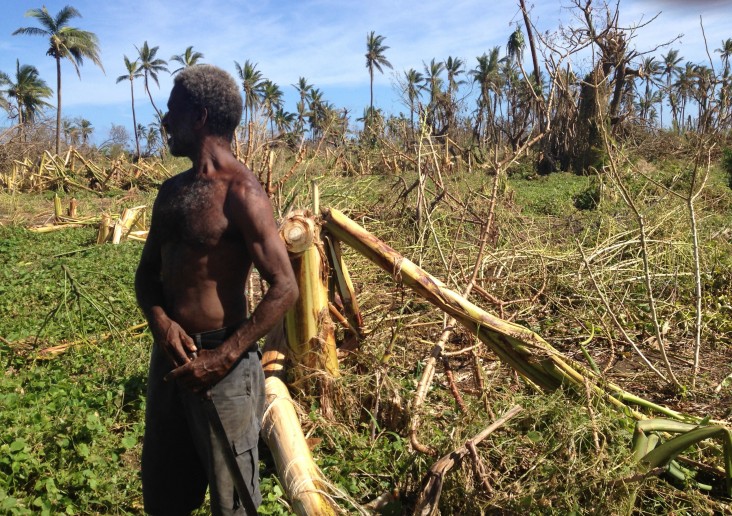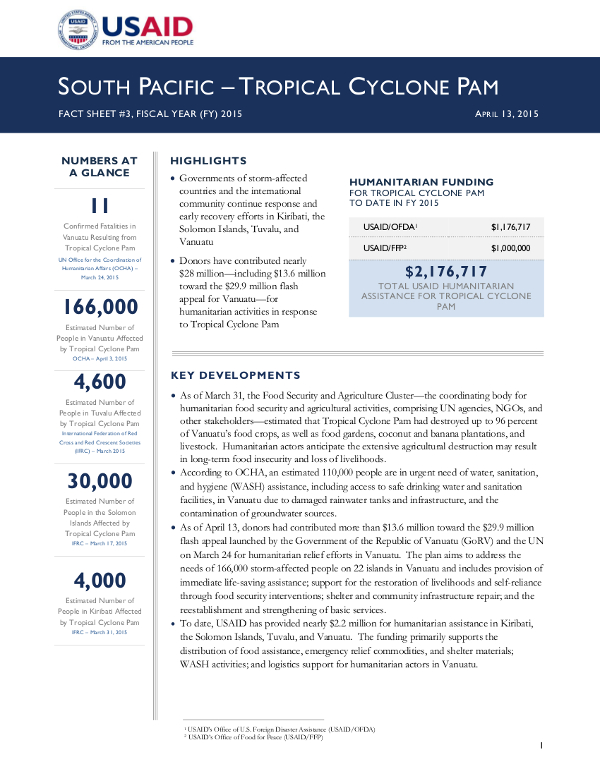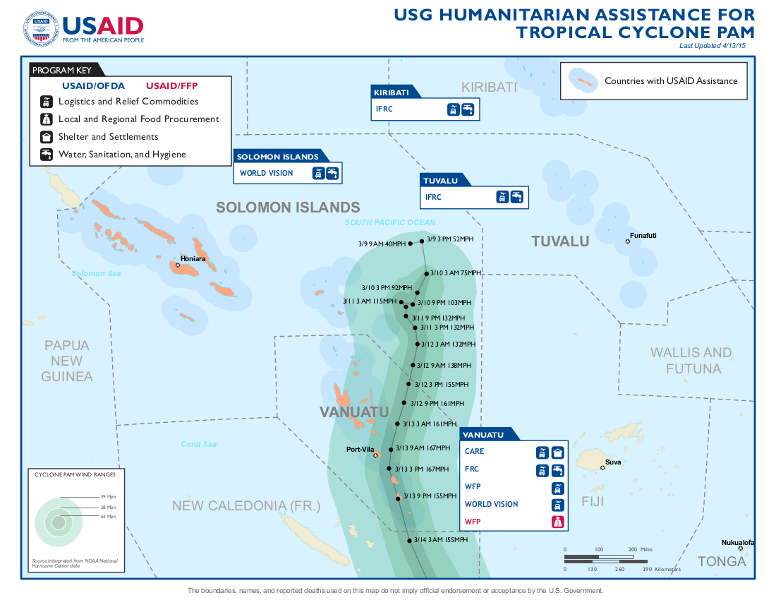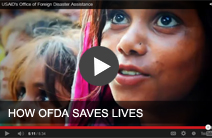- What We Do
- Agriculture and Food Security
- Democracy, Human Rights and Governance
- Economic Growth and Trade
- Education
- Ending Extreme Poverty
- Environment and Global Climate Change
- Gender Equality and Women's Empowerment
- Global Health
- Water and Sanitation
- Working in Crises and Conflict
- Disaster Assistance
- Political Transition Initiatives
- Conflict Mitigation and Prevention
- Countering Violent Extremism
- Disaster Risk Reduction
- Peacebuilding and Reconciliation
- Providing Safe & Secure Environments for Development
- Recovering From Crisis
- Resilience
- Tech Challenge for Atrocity Prevention
- World Humanitarian Day
- U.S. Global Development Lab

Latest Tropical Cyclone Pam Fact Sheet
Tropical Cyclone Pam Fact Sheet #3 - 04-13-2015 ![]() (pdf - 284k)
(pdf - 284k)
Tropical Cyclone Pam Map - 04-13-2015 ![]() (pdf - 287k)
(pdf - 287k)
Key Developments
As of March 31, the Food Security and Agriculture Cluster—the coordinating body for humanitarian food security and agricultural activities, comprising UN agencies, NGOs, and other stakeholders—estimated that Tropical Cyclone Pam had destroyed up to 96 percent of Vanuatu’s food crops, as well as food gardens, coconut and banana plantations, and livestock. Humanitarian actors anticipate the extensive agricultural destruction may result in long-term food insecurity and loss of livelihoods.
According to the UN Office for the Coordination of Humanitarian Affairs (OCHA), an estimated 110,000 people are in urgent need of water, sanitation, and hygiene (WASH) assistance, including access to safe drinking water and sanitation facilities, in Vanuatu due to damaged rainwater tanks and infrastructure, and the contamination of groundwater sources.
As of April 13, donors had contributed more than $13.6 million toward the $29.9 million flash appeal launched by the Government of the Republic of Vanuatu (GoRV) and the UN on March 24 for humanitarian relief efforts in Vanuatu. The plan aims to address the needs of 166,000 storm-affected people on 22 islands in Vanuatu and includes provision of immediate life-saving assistance; support for the restoration of livelihoods and self-reliance through food security interventions; shelter and community infrastructure repair; and the reestablishment and strengthening of basic services.
To date, USAID has provided nearly $2.2 million for humanitarian assistance in Kiribati, the Solomon Islands, Tuvalu, and Vanuatu. The funding primarily supports the distribution of food assistance, emergency relief commodities, and shelter materials; WASH activities; and logistics support for humanitarian actors in Vanuatu.
Background
In early March, Tropical Cyclone Pam brought heavy rains, storm surge, storm tides, and damaging winds to several islands in the South Pacific Ocean, damaging houses, crops, and infrastructure. In Kiribati, wave activity and storm surges—compounded by seasonal high tides—triggered significant flooding in South Tarawa and the country’s outer islands, affecting up to 4,000 people, according to the International Federation of Red Cross and Red Crescent Societies (IFRC). Assessments of Kiribati’s remote islands revealed greater storm damage than initially anticipated. In Tuvalu, IFRC estimated that storm affected an estimated 4,600 people, representing nearly one-half of the country’s total population. The Government of Tuvalu declared a state of emergency on March 13 and appealed for international assistance on the following day. In the Solomon Islands, the tropical cyclone may have affected as many as 3,000 households, according to international media. As of March 17, the Government of the Solomon Islands had requested assistance for cyclone-affected populations in Guadalcanal, Isabel, Makira, and Malaita provinces, in addition to Temotu Province, according to the UN Children’s Fund (UNICEF).
On March 13 and 14, Tropical Cyclone Pam passed over Vanuatu’s central and southern islands as a Category 5 storm, causing significant damage. The Government of the Republic of Vanuatu estimated that the storm affected the country’s entire population of approximately 262,000 people and declared a state of emergency for Shefa Province, where the capital city of Port Vila is situated, noting that the designation may be extended to additional provinces following further assessments.
On March 14, U.S. Ambassador to Papua New Guinea, Solomon Islands, and Vanuatu Walter North declared a disaster in Vanuatu due to the effects of Tropical Cyclone Pam. In response, USAID’s Office of U.S. Foreign Disaster Assistance (USAID/OFDA) provided $100,000 through USAID/Philippines to the French Red Cross to distribute emergency relief supplies and offer water, sanitation, and hygiene (WASH) assistance in evacuation shelters, as well as support evacuees as they return home.
On March 15, U.S. Ambassador to Fiji, Kiribati, Nauru, Tonga, and Tuvalu Judith Beth Cefkin declared a disaster in Tuvalu due to the effects of Tropical Cyclone Pam. In response, USAID/OFDA provided $50,000 through USAID/Philippines to IFRC to distribute emergency relief items and offer basic WASH assistance to cyclone-affected households.
On March 18, U.S Chargé d'Affaires for Papua New Guinea, Solomon Islands, and Vanuatu Melanie Higgins declared a disaster in the Solomon Islands due to the effects of Tropical Cyclone Pam. In response, USAID/OFDA provided $50,000 through USAID/Philippines to World Vision, a non-governmental organization, to assist storm-affected households in the Solomon Islands.
On March 30, U.S. Chargé d'Affaires for Fiji, Kiribati, Nauru, Tonga, and Tuvalu Douglas Sonnek declared a disaster in Kiribati due to the effects of Tropical Cyclone Pam. In response, USAID/OFDA provided $50,000 through USAID/Philippines to IFRC to distribute emergency relief items and offer basic WASH assistance to populations in Kiribati’s most affected areas.










Comment
Make a general inquiry or suggest an improvement.